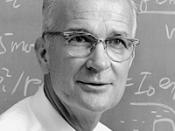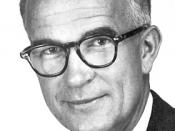William Shockley: Father of the Bipolar Transistor
William Shockley was born in 1910 to American parents in London, England. He graduated from the California Institute of Technology before getting a PhD in physics from MIT. After that, he went to work at Bell Labs, taking a brief break for radar research for the military during WWII, returning to Bell after the war ended. During his schooling at CIT, Shockley married Jean Bailey, who gave birth to Alison Shockley in 1934. Later, Shockley would divorce Jean and marry Emmy Lanning, who would have a son, Dick. Shockley headed the Bell Lab's solid-state physics lab for 19 years before starting his own company: Shockley's Semiconductor Laboratory, a division of Beckman Instruments. He would sell the company in 1960, and in 1968 it would be bought by ITT. William Shockley would die in 1989 of prostate cancer. Over his lifetime he would receive the Comstock prize in physics, the Oliver E.
Buckley Solid State Physics Prize, was the co-recipient of the Nobel Prize, the Holley Medal, the Maurice Liebman Memorial Prize, and several honorary doctorates from various universities.
William Shockley's greatest contribution to physics was the bipolar transistor; a semiconductor device used mainly for the amplification of AC signals. The modern bipolar transistor is made of two types of semiconductor materials sandwiched together. These materials, dubbed "N-type" and "P-type", have either an over-abundance of electrons, giving it an overall negative charge (N-type), or a deficiency of electrons, giving it an overall positive charge (P-type). These materials are crystals, generally silicon or germanium, that have had impurities added to them to give them these charges in a process called "doping". In a bipolar transistor P and N-type materials are arranged in either a PNP or NPN configuration "sandwich". The electrical connections...


